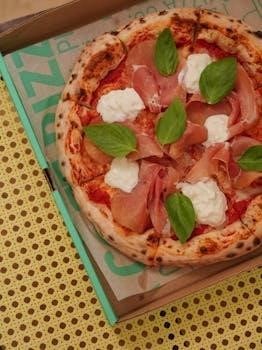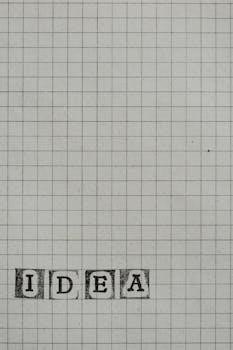Embark on a rewarding woodworking journey with our bread box plans! These plans‚ often available in PDF format‚ offer a comprehensive guide to crafting your own bread storage solution. Discover the joy of building a functional and beautiful kitchen accessory.
Benefits of Using a Bread Box
A bread box extends the life of your baked goods‚ keeping them fresher for longer. It also protects bread from pests‚ like insects. Finally‚ a bread box adds aesthetic value to your kitchen countertop.
Maintaining Bread Freshness
The primary benefit of using a bread box is its ability to maintain the freshness of your bread. Bread boxes achieve this by creating a microclimate that balances humidity levels. This controlled environment prevents bread from drying out too quickly or becoming overly moist‚ which can lead to mold growth. By slowing down the staling process‚ a bread box ensures your loaves‚ rolls‚ and pastries remain delicious and usable for an extended period. Properly stored bread is less likely to be wasted‚ saving you money and reducing food waste.
Protecting Bread from Pests
Beyond freshness‚ a bread box serves as a crucial barrier against unwanted pests. Openly stored bread is vulnerable to insects‚ rodents‚ and even household pets seeking an easy meal. A well-constructed bread box provides a secure enclosure‚ preventing these pests from accessing and contaminating your baked goods. This protection not only preserves your food supply but also safeguards your family’s health by eliminating the risk of consuming bread that has been exposed to potentially harmful bacteria or allergens carried by pests. A bread box is a simple yet effective solution for maintaining a clean and hygienic kitchen environment.
Aesthetic Kitchen Addition
A bread box isn’t merely a functional storage container; it’s also a charming addition to your kitchen decor. With a variety of styles and materials available‚ a bread box can seamlessly blend with or enhance your existing aesthetic. From rustic wooden designs that evoke a farmhouse feel to sleek‚ modern metal options‚ there’s a bread box to complement every taste. A well-chosen bread box can add character and warmth to your countertop‚ turning a practical item into a stylish statement piece that reflects your personal style and elevates the overall ambiance of your kitchen space. It’s a subtle way to showcase your design sensibilities.

Types of Bread Box Designs
Explore the diverse world of bread box designs! From classic roll-top styles to modern two-story models‚ discover the perfect design to match your kitchen and storage needs. Each design offers a unique blend of functionality.
Roll-Top Bread Boxes
Roll-top bread boxes are a classic choice‚ celebrated for their timeless design and efficient use of space. The smooth‚ sliding door mechanism allows for easy access to your bread while keeping it securely enclosed. These bread boxes often evoke a vintage charm‚ adding a touch of nostalgia to any kitchen.
The curved top also prevents items from being stacked upon the bread box. Plans are available from many sources‚ and are considered a more difficult project for someone with woodworking experience. Many variations exist for wood choice‚ size‚ and shape.
Drop-Front Bread Boxes
Drop-front bread boxes offer a convenient and stylish way to store your baked goods. The door hinges at the bottom‚ swinging downward to provide easy access to the contents inside. This design often doubles as a temporary work surface‚ perfect for slicing bread or preparing sandwiches.
The simple design lends itself to customization with wood choices‚ paint‚ or other decorative elements. The wood dowels provide extra stability to the front door. The design plans often include full-size illustrations and instructions for ease of building.
Two-Story Bread Boxes
Maximize your kitchen storage with a two-story bread box‚ a design that offers ample space for multiple loaves and other baked goods. These bread boxes often feature separate compartments or drawers‚ allowing you to organize your items effectively.
Some designs incorporate traditional woodworking techniques‚ such as mortise and tenon joinery‚ adding a touch of classic craftsmanship. The two-tiered structure not only provides extra storage‚ but also creates an interesting visual element. They can also include drawers for storing jams and jellies.
Materials for Building a Bread Box
Selecting the right materials is crucial for building a durable and aesthetically pleasing bread box. Options range from hardwoods and softwoods to plywood‚ each offering unique characteristics and benefits for your project.
Hardwoods vs. Softwoods
When choosing wood for your bread box‚ consider the differences between hardwoods and softwoods. Hardwoods like beech offer durability and a beautiful grain‚ ideal for a lasting‚ elegant piece. Softwoods‚ such as pine or cedar‚ present a more affordable option while still providing decent durability‚ especially when properly sealed. Their ease of workability makes them great for beginners‚ allowing for easier cutting and assembly. Ultimately‚ the best choice depends on your budget‚ desired aesthetic‚ and woodworking skill level. Consider the project’s needs and your personal preferences.
Plywood Options
Exploring plywood as a material for your bread box offers a versatile and budget-friendly alternative to solid wood. Plywood provides stability and resists warping‚ ensuring a long-lasting structure for your bread storage. Different grades of plywood offer varying surface finishes‚ allowing you to choose one that suits your desired aesthetic. Consider hardwood-veneered plywood for a more refined look‚ mimicking the appearance of solid wood. When selecting plywood‚ prioritize formaldehyde-free options for food safety. Plywood presents a cost-effective and reliable option for your DIY roll top bread box or other designs‚ balancing affordability and durability.
Other Material Considerations
Beyond wood and plywood‚ various other materials can enhance or complement your bread box design. Copper punch panels can add a unique decorative accent. Consider using reclaimed pallet wood for a rustic‚ eco-friendly build‚ embracing imperfections for character. Explore acrylic or glass for door panels to showcase your baked goods while maintaining freshness. Hardware choices‚ like hinges and latches‚ impact both functionality and aesthetics; select durable‚ corrosion-resistant options. Finishes‚ such as food-safe oils or varnishes‚ protect the wood and enhance its natural beauty. By thoughtfully integrating diverse materials‚ you can create a truly personalized and functional bread box.

Essential Tools for Bread Box Construction
Constructing a bread box requires a selection of essential woodworking tools to ensure precision and efficiency. A miter saw is crucial for accurate angle and straight cuts‚ while a circular saw can handle larger pieces of wood. A router is valuable for creating decorative edges or intricate joinery. Hand tools like chisels and hand planes can refine joints and smooth surfaces. Measuring tools‚ including a tape measure and combination square‚ are vital for precise dimensions. Don’t forget safety gear‚ such as safety glasses and ear protection. Clamps are essential for holding pieces together during glue-up. With these tools‚ you’ll be well-equipped to bring your bread box plans to life.
Step-by-Step Guide to Building a Simple Bread Box
Begin by gathering your materials and tools‚ referring to your chosen bread box plan for specific dimensions. Cut the wood pieces according to the plan‚ ensuring accuracy for a snug fit. Assemble the box’s sides‚ bottom‚ and back using wood glue and screws or nails‚ clamping the pieces together until the glue dries. Construct the door‚ attaching hinges to allow for smooth opening and closing. Consider adding a magnetic catch to keep the door securely closed. Sand all surfaces to create a smooth finish. Apply your desired finish‚ such as paint‚ stain‚ or varnish‚ to protect the wood and enhance its appearance. Finally‚ attach any decorative elements‚ and your bread box is ready to use!
Free Bread Box Plans and Resources (PDF)
Explore the world of woodworking without breaking the bank by accessing free bread box plans online! Numerous websites offer downloadable PDF plans for various bread box designs‚ catering to different skill levels and aesthetic preferences. These resources often include detailed diagrams‚ step-by-step instructions‚ and material lists‚ making the building process straightforward. Some websites even provide video tutorials to guide you through each stage. Take advantage of these free resources to create a functional and stylish bread box for your kitchen while honing your woodworking skills. Remember to always review the plans thoroughly before starting your project!

Customization Ideas for Your Bread Box
Unleash your creativity! Personalize your bread box with unique touches. Explore wood burning‚ decorative accents‚ or add shelves. Selecting the right finish enhances the look and protects the wood. Make it your own!
Wood Burning and Decorative Accents
Elevate your bread box with personalized wood-burned designs or decorative accents. Consider adding intricate patterns‚ family names‚ or even quotes related to baking and home. Reclaimed pallet wood can add a rustic touch‚ especially when combined with unique burning designs. Explore copper punch panel accents for a touch of elegance. These artistic elements transform a simple bread box into a cherished‚ customized piece that reflects your personal style and enhances your kitchen’s aesthetic. Experiment with various techniques to achieve the perfect look.
Adding Shelves or Drawers
Expand the functionality of your bread box by incorporating shelves or drawers. A two-story design can accommodate multiple loaves or different types of baked goods. Drawers are perfect for storing jams‚ jellies‚ and spreads‚ keeping everything organized. Integrate a cutting board shelf for convenient bread slicing. These additions optimize space and transform your bread box into a versatile kitchen storage unit. Consider a roll-top drawer mechanism for smooth access. Ensure proper spacing to prevent items from sticking. Plan your dimensions carefully to maximize usability and appeal.
Choosing the Right Finish
Selecting the appropriate finish for your bread box is essential for both aesthetics and protection. Varnish or sealant enhances durability‚ especially for softwoods like pine or cedar. Consider food-safe finishes to ensure no harmful chemicals come into contact with your bread. Pickling‚ oiling‚ and waxing can create a unique look‚ while paint allows for vibrant customization. Choose a finish that complements your kitchen decor and highlights the wood’s natural grain. Properly applied finishes protect against moisture‚ preventing mold and maintaining the bread box’s longevity. Always follow manufacturer instructions for application and drying times to achieve the best results.

Troubleshooting Common Bread Box Building Issues
Encountering snags during your bread box build? Addressing common issues promptly ensures a successful project. Warped wood can cause alignment problems; select straight‚ quality lumber to begin. Misaligned joints may require disassembly and re-gluing with proper clamping. Ensure accurate measurements to avoid ill-fitting components. Hinges that don’t align can be adjusted with shims or by re-drilling pilot holes. Uneven finishes often result from improper sanding or application; sand thoroughly and apply thin‚ even coats. Doors that stick may need sanding or planing for a smoother fit. By identifying and resolving these common issues‚ you can create a functional and attractive bread box.
Alternative Uses for Bread Boxes
Beyond bread‚ these versatile boxes offer creative storage solutions throughout your home. Transform a bread box into a charming sewing kit organizer‚ keeping threads‚ needles‚ and notions neatly contained. In the office‚ repurpose it as a stylish desk caddy for pens‚ paperclips‚ and stationery. For crafters‚ a bread box becomes an ideal storage unit for paintbrushes‚ small tools‚ and art supplies. Consider using it in the bathroom to organize toiletries like cotton balls‚ makeup brushes‚ or small towels. It can even be used as a unique planter to grow herbs. The possibilities are endless‚ limited only by your imagination.
